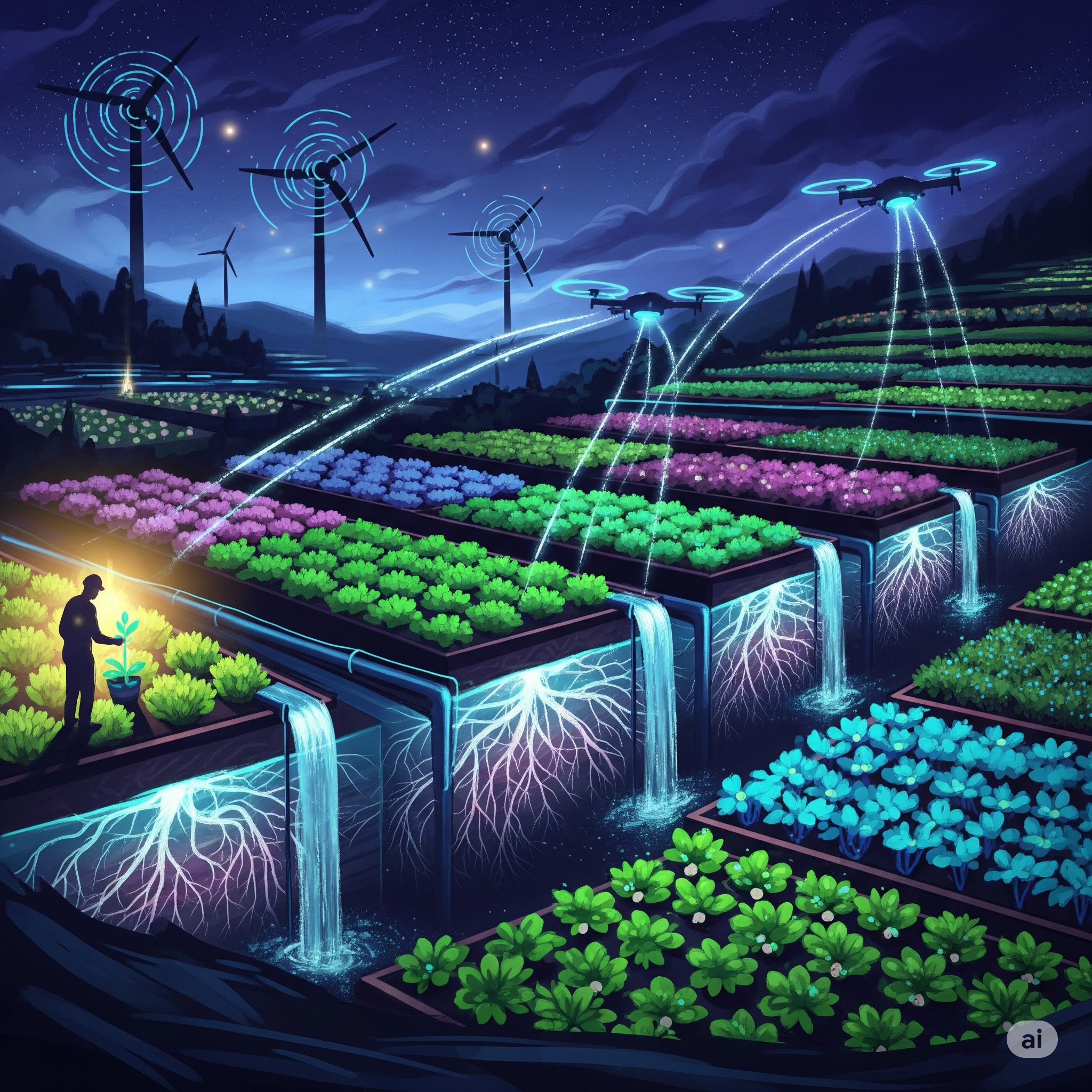Introduction
Agriculture, the backbone of human civilization, is under unprecedented pressure. Climate change, driven by rising greenhouse gas emissions, is affecting crop yields, soil health, water availability, and the livelihood of farmers—especially in climate-vulnerable countries like India. In response, the global agricultural community is turning toward Sustainable Agricultural Practices (SAPs) as a robust strategy to build climate resilience while maintaining food security and ecosystem balance.
This article explores the core concepts, strategies, and real-world examples of sustainable agricultural practices aimed at mitigating and adapting to climate change.
What Is Climate Resilience in Agriculture?
Climate resilience refers to the ability of agricultural systems to absorb, recover, and adapt to climate-related stresses such as droughts, floods, erratic rainfall, heatwaves, and shifting seasons. A climate-resilient system ensures:
- Long-term productivity
- Resource conservation
- Protection of farmer livelihoods
- Food security under changing climatic conditions
Sustainable agricultural practices are central to achieving this resilience.
Understanding Sustainable Agricultural Practices (SAPs)
Sustainable agriculture involves farming methods that protect the environment, enhance soil fertility, reduce greenhouse gas emissions, and improve social equity.
Key features of SAPs:
- Environmentally friendly
- Economically viable
- Socially responsible
- Technologically adaptable
Why India Needs Climate-Resilient Agriculture
India is home to:
- 140 million hectares of cultivated land
- Over 85% small and marginal farmers
- Heavy dependence on monsoon (60% rain-fed farming)
Challenges include:
- Erratic rainfall and water stress
- Soil degradation due to overuse of fertilizers
- Heat stress and pest outbreaks
- Frequent floods and droughts
These realities demand urgent adoption of SAPs tailored to local conditions.
Key Sustainable Agricultural Practices for Climate Resilience
🌾 1. Crop Diversification
- What it is: Growing a mix of crops (cereals, pulses, vegetables) instead of monoculture.
- Benefits:
- Reduces risk of complete crop failure
- Improves soil health
- Enhances dietary diversity and income
- Example: Intercropping millets with pulses in Karnataka to withstand dry spells.
💧 2. Efficient Water Management
- Techniques:
- Drip and sprinkler irrigation
- Rainwater harvesting
- Laser land leveling
- Benefits:
- Saves water (30–60% reduction in usage)
- Improves irrigation efficiency
- Example: The use of “Pani Panchayats” in Odisha for community water sharing and conservation.
🌿 3. Agroforestry
- What it is: Integrating trees with crops and/or livestock.
- Benefits:
- Improves carbon sequestration
- Reduces soil erosion
- Provides income from timber, fruits, and fodder
- Example: Moringa and mango plantations integrated with crops in Tamil Nadu.
🪱 4. Organic and Natural Farming
- Practices:
- Use of compost, green manure, and biofertilizers
- Zero Budget Natural Farming (ZBNF)
- Benefits:
- Restores soil biodiversity
- Reduces chemical input costs
- Example: Andhra Pradesh scaling ZBNF across 6 million farms.
🌾 5. Climate-Resilient Crop Varieties
- What they are: Crops genetically improved to withstand drought, heat, flood, or salinity.
- Benefits:
- Maintains yield under adverse conditions
- Examples:
- Drought-tolerant maize (DTM)
- Submergence-tolerant rice (e.g., Swarna Sub1)
🐄 6. Integrated Farming Systems (IFS)
- Definition: Combining crops, livestock, fishery, and horticulture.
- Benefits:
- Enhances resource use efficiency
- Diversifies income sources
- Reduces climate vulnerability
- Example: Kerala’s integrated duck-fish-rice farming in flood-prone zones.
🐞 7. Integrated Pest and Nutrient Management (IPM & INM)
- IPM: Use of biological controls (like ladybugs), crop rotation, and traps instead of chemical pesticides.
- INM: Balanced use of organic and inorganic fertilizers.
- Benefits:
- Reduces pest resistance
- Preserves soil and water health
- Example: Adoption of pheromone traps and neem-based pesticides in Maharashtra’s cotton fields.
🔄 8. Conservation Agriculture
- Techniques:
- Minimum soil disturbance (no-till farming)
- Permanent soil cover (mulching)
- Crop rotation
- Benefits:
- Improves soil structure and water retention
- Reduces erosion
- Example: Wheat sowing with zero-till seeders in Haryana reduces fuel and water use.
🌎 9. Carbon Farming and Climate-Smart Practices
- What it involves: Sequestration of carbon in soil and vegetation through good practices.
- Technologies:
- Use of biochar
- Soil carbon monitoring
- Benefit:
- Reduces atmospheric CO₂
- Qualifies farmers for carbon credits
- Example: Carbon farming pilots in Madhya Pradesh backed by international carbon finance platforms.
Technological Enablers of Sustainable Practices
📱 1. Mobile Advisory Services
Apps like:
- Kisan Suvidha
- AgriApp
- IFFCO Kisan
Provide weather forecasts, pest alerts, and market prices in local languages.
📡 2. Remote Sensing and GIS
Used for:
- Monitoring drought/flood
- Predicting pest outbreaks
- Soil health mapping
🤖 3. AI and IoT in Precision Farming
- AI-based crop prediction models
- IoT-enabled soil moisture sensors
- Smart irrigation scheduling
Government Initiatives Promoting SAPs
- Paramparagat Krishi Vikas Yojana (PKVY) – Promotes organic farming
- National Mission for Sustainable Agriculture (NMSA) – Focus on soil health, rainfed farming, and water use efficiency
- Rashtriya Krishi Vikas Yojana (RKVY) – Flexible funding for innovations
- Soil Health Card Scheme – Personalized soil nutrition planning
- PM-KUSUM – Solar pumps for sustainable irrigation
- Agri-Infra Fund – Supports cold chains and post-harvest storage
Benefits of Sustainable Agriculture for Climate Resilience
| Benefit | How It Helps |
|---|---|
| Reduced vulnerability | Withstands climate shocks like floods, droughts |
| Increased productivity | Maintains or boosts yield with eco-friendly methods |
| Improved soil and water health | Restores ecosystem balance |
| Enhanced income and equity | Multiple income streams and reduced input costs |
| Food and nutritional security | Diversified and resilient crop systems |
Barriers to Adoption
Despite its promise, SAPs face several adoption challenges:
- Lack of awareness among smallholders
- High initial costs (e.g., drip systems)
- Limited access to quality inputs (biofertilizers, resilient seeds)
- Market and pricing issues for organic produce
- Fragmented landholdings and poor extension services
Way Forward: A Climate-Ready Farming Future
- Strengthen Extension Services: Train farmers in SAPs using field schools, videos, and mobile platforms.
- Incentivize Adoption: Provide subsidies or carbon credits for eco-friendly practices.
- Improve Market Access: Link sustainable produce to premium or certified markets.
- Support Research & Innovation: Invest in crop genetics, water-efficient tech, and AI tools.
- Promote Farmer Collectives: FPOs can help smallholders adopt SAPs collectively.
Conclusion
Sustainable agricultural practices are not just buzzwords — they are lifelines for farmers navigating an uncertain climate future. By combining traditional knowledge, scientific innovation, and policy support, India can build a farming system that is productive, inclusive, and climate-resilient.
Empowering farmers to embrace sustainability today ensures food security, environmental health, and rural prosperity for tomorrow.




